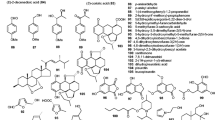Abstract
A nematicidal toxin was purified fromPleurotus ostreatus NRRL 3526 grown on moistened, autoclaved wheat straw for 30 days at room temperature (21–33°C). The active compound, at a concentration of 300 ppm, immobilized 95% of test nematodes (Panagrellus redivivus) within 1 hr. Immobilized nematodes did not recover, even after being rinsed with deionized water. The toxin was identified astrans-2-decenedioic acid.
Similar content being viewed by others
References
Balan, J., andGerber, N.N. 1972. Attraction and killing of the nematodePanagrellus redivivus by the predaceous fungusArthrobotrys dactyloides.Nematologia 18:163–173.
Balan, J., Krizkova, L., Nemec, P., andVollek, V. 1974. Production of nematode-attracting and nematicidal substances by predacious fungi.Folia Microbiol. 19:512–519.
Barron, G.L. 1977. The Nematode-Destroying Fungi. Canadian Biological Publications, Guelph, Ontario.
Barron, G.L., andThorn, R.G. 1987. Destraction of nematodes by species ofPleurotus.Can. J. Bot. 65:774–778.
Brenner, S. 1974. The genetics ofCaenorhabditis elegans.Genetics 77:71–94.
Cram, D.J., andTishler, M. 1948. Mold metabolites. I. Isolation of several compounds from clinical penicillin.J. Am. Chem. Soc. 70:4238–4239.
Fogleman, J.C., andKircher, H.W. 1986. Differential effects of fatty acid chain length on the viability of two species of catophilicDrosophila.Comp. Biochem. Physiol. 83A:761–764.
Freese, E. 1978. Mechanism of growth inhibition by lipophilic acids, pp. 123–131,in J.J. Kabara (ed.). The Pharmacological Effects of Lipids. The American Oil Chemists' Society, Champaign, Illinois.
Giuma, A.Y., andCooke, R.C. 1971. Nematotoxin production byNematoctonus haptocladus andN. concurrens.Trans. Br. Mycol. Soc. 56:89–94.
Giuma, A.Y., Hackett, A.M., andCooke, R.C. 1973. Thermostable nematotoxins produced by germinating conidia of some endozoic fungi.Trans. Br. Mycol. Soc. 60:49–56.
Hunkova, Z., andFencl, Z. 1977. Toxic effects of fatty acids on yeast cells: Dependence of inhibitory effects of fatty acid concentration.Biotechnol. Bioeng. 19:1623–1641.
Kennedy, N., andTampion, J. 1978. A nematotoxin fromNematoctonus robustus.Trans. Br. Mycol. Soc. 70:140–141.
Krizkova, L., Balan, J., Nemec, P., andKolozvary, A. 1976. Predaceous fungiDactylaria pyriformis andD. thaumasia: Production of attractants and nematicides.Folia Microbiol. 21:493–494.
Munakata, K. 1983. Nematicidal natural products, pp. 299–311, in D.L. Whitehead and W.S. Bowers (eds.). Natural Products for Innovative Pest Management. Pergamon Press, New York.
Olthof, T.H.A., andEstey, R.H. 1963. A nematotoxin produced by the nematophagous fungusArthrobotrys oligospora Fresenius.Nature 197:514–515.
Puritch, G.S. 1978. Biocidal effects of fatty acid salts on various forest insect pest, pp. 105–112, in J.J. Kabara (ed.). The Pharmacological Effects of Lipids. The American Oil Chemists' Society, Champaign, Illinois.
Teh, J.S. 1974. Toxicity of short-chain fatty acids and alcohols towardsCladosporium resinae.Appl. Microbiol. 28:840–844.
Thorn, R.G., andBarron, G.L. 1984. Carnivorous mushrooms.Science 224:76–78.
Wurzenberger, M., andGrosch, W. 1986. Enzymic oxidation of linolenic acid to 1,Z-5-octadien-3-ol,Z-2,Z-5-octadien-1-ol and 10-oxo-E-8-decenoic acid by a protein fraction from mushrooms (Psalliota bispora).Lipids 21:261–266.
Author information
Authors and Affiliations
Additional information
The mention of firm or trade names does not imply that they are endorsed or recommended by the U.S. Department of Agriculture over other firms or similar products not mentioned.
Rights and permissions
About this article
Cite this article
Kwok, O.C.H., Plattner, R., Weisleder, D. et al. A nematicidal toxin fromPleurotus ostreatus NRRL 3526. J Chem Ecol 18, 127–136 (1992). https://doi.org/10.1007/BF00993748
Received:
Accepted:
Issue Date:
DOI: https://doi.org/10.1007/BF00993748




